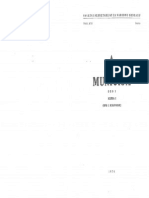Municija Sa Belim Fosforom

Municija Sa Belim Fosforom Full
URGENTNA I RATNA HIRURGIJA IMPRESUM MILAN DRAGOVI Profesor hirurgije Medicinskog fakulteta Univerziteta u Beogradu Dopisni lan Crnogorske akademije nauka i umjetnosti. Bosna i Hercegovina ima 21 hiljadu tona ukupnih zaliha municije i minsko-eksplozivnih sredstava. Značajna je količina nestabilne municije koja se mora uništiti – 14 hiljada tona. Proces uništavanja tekao je sporo. Nedavno je intenziviran, ali nam za uništavanje i dalje treba nekoliko godina.

. Abstract: In this work, a comparative analysis of two iron bullets found in The Royal Ammunition Factory of Eugi in Navarra (Spain) was performed. Both bullets presented a spherical shape with a relatively good state of preservation, belonging to the last years of the factory production (1766-1850). Several techniques such as microhardness, X-ray fluorescence (XRF), light (LM) and scanning electron microscopy (SEM), optical mission spectroscopy (OES) and energy dispersive X-ray spectroscopy (EDX) analysis were used in order to identify the manufacturing process of the two bullets. The analyses of the microstructures carried out by LM and SEM showed that one bullet was composed of white cast iron with a pearlitic matrix, steadite and graphite; while the other was composed of grey cast iron with a pearlitic matrix, graphite and a low amount of steadite. The chemical analysis of the bullets carried out by OES indicated significant differences in the amount of silicon and phosphorous. The variation in silicon content could suggest that the foundry temperature under oxidizing environment varied during the casting.
Municija Sa Belim Fosforom English
The SEM and EDX analyses showed both bullets had manganese sulphide inclusions but only one of the bullets exhibited titanium and vanadium inclusions. The microhardness analyses carried out revealed Vickers hardness differences along the diameter. This variation could be explained by the differences in cooling rate along the diameter. Based on the physical characteristics of the bullets and on the obtained results, it can be concluded that one of the bullets could have been used as a grapeshot projectile and the other one as a bullet for ribauldequins. In addition, calcined ore and slag found in this factory were also analysed. The variation found in their chemical composition corroborated that the foundry temperature employed during the manufacturing process was low, the slag being enriched in Si, Al and Mn elements.
Municija Sa Belim Fosforom En
Copyright of Journal of Mining & Metallurgy. Section B: Metallurgy is the property of Journal of Mining & Metallurgy and its content may not be copied or emailed to multiple sites or posted to a listserv without the copyright holder's express written permission.
However, users may print, download, or email articles for individual use. This abstract may be abridged. No warranty is given about the accuracy of the copy. Users should refer to the original published version of the material for the full abstract. For access to this entire article and additional high quality information, please check with your college/university library, local public library, or affiliated institution.Important User Information: Remote access to EBSCO's databases is permitted to patrons of subscribing institutions accessing from remote locations for personal, non-commercial use. However, remote access to EBSCO's databases from non-subscribing institutions is not allowed if the purpose of the use is for commercial gain through cost reduction or avoidance for a non-subscribing institution.
Latest News
- Download The Sims 4 Terbaru 2019
- Once Upon A Time Not Long Ago Remix
- Browning X Bolt Stock
- Wonder Woman 1080p Bluray X265 Hevc 10bit 7 1ch
- Download Keygen Accurate 4 Enterprise
- Cara Membuat File Commander Jadi Premium
- Hancom Office 2014 Apk Crack
- Fifa 13 Free Download
- Download Game Rise Of Nation
- Crack Avast Premier 2019
- Amiga Kickstart Roms Pack
- Dragon Tales To Kingdom Come